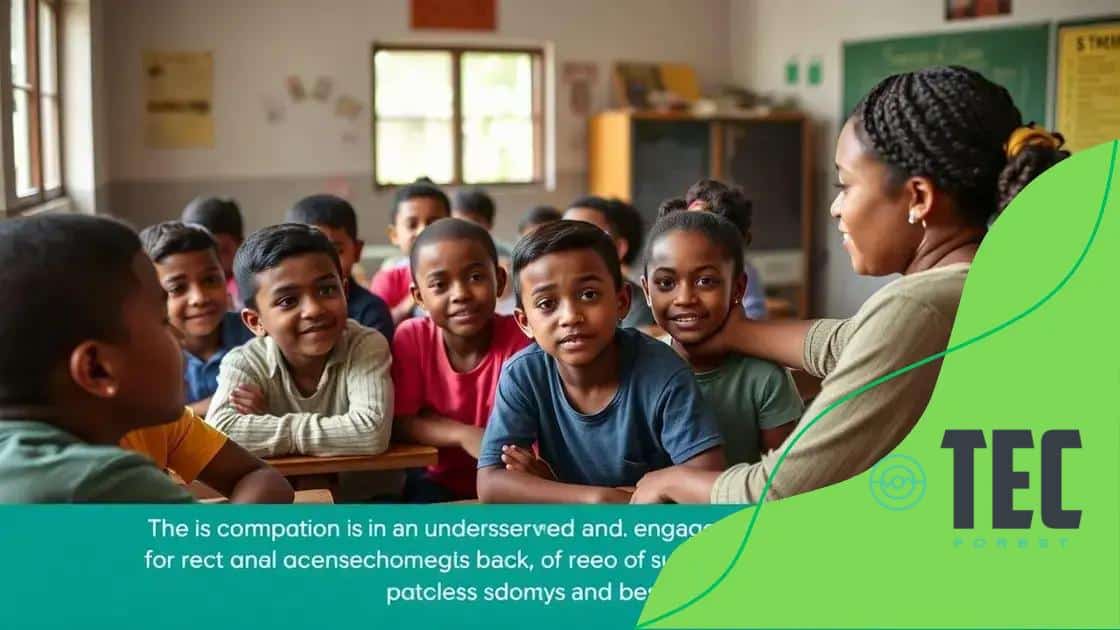Advertisement
Learning loss accelerates equity gaps post-pandemic, necessitating targeted strategies like technology integration, mental health support, and community engagement to ensure equitable access to education for all students.
Learning loss accelerates equity gaps post-pandemic, raising important questions for how education can move forward. Have you noticed the disparities in learning outcomes? This article delves into the issues at hand.
Advertisement
Understanding learning loss after the pandemic
Understanding learning loss after the pandemic is crucial for addressing the needs of students. Many learners have faced challenges that hinder their academic growth. This loss of knowledge and skills can have lasting effects on their education and future opportunities.
What is Learning Loss?
Learning loss refers to the decline in knowledge and skills that students may experience, especially due to significant disruptions in their education. This can happen for various reasons, such as:
Advertisement
- Extended school closures
- Lack of access to resources
- Inconsistent teaching methods
- Emotional and mental health challenges
The impact of learning loss can differ between students, particularly affecting those from underserved communities. These students often face additional barriers that compound the effect of lost learning.
Contributing Factors
Several factors contribute to learning loss, especially in the wake of the pandemic. When schools transitioned to online learning, many students struggled with technology and engagement. Some students lacked the necessary devices or internet access, which made learning difficult.
Additionally, the absence of in-person interactions with teachers and peers affected students’ motivation and mental well-being. Furthermore, many parents faced their own obstacles, such as job loss, which limited their ability to support their children’s learning during this time.
Addressing Learning Loss
It is essential for schools and communities to implement strategies that can help mitigate learning loss. Some effective methods include:
- Providing targeted tutoring and support
- Extending the school year to recapture lost learning
- Incorporating social-emotional learning in classrooms
- Creating engaging and interactive learning environments
By recognizing and addressing these challenges, educators and parents can work together to support students in overcoming the effects of learning loss. Strategies that focus on equity in education will be vital for ensuring all students can thrive in their learning journey.
The impact on underserved communities

The impact of learning loss on underserved communities is profound. Many students in these areas face unique challenges that affect their ability to learn and grow academically. These challenges have been intensified in the wake of the pandemic.
Disparities in Access
Underserved communities often experience disparities in access to quality education. Schools in these areas may lack resources, such as advanced technology and trained teachers, which can contribute to learning loss. Additionally, many students may not have access to reliable internet, which is crucial for online learning.
- Limited educational materials available
- Higher student-to-teacher ratios
- Lack of after-school programs
- Inadequate facilities and infrastructure
This unequal access creates a cycle where students from underserved communities are at a disadvantage compared to their peers, hindering their educational progress.
Emotional and Social Challenges
Beyond resource limitations, many students in underserved communities face emotional and social challenges. Factors such as poverty, family instability, and community violence can greatly affect their mental health and focus. This impact can lead to decreased motivation and engagement in the classroom, worsening their academic situation.
Moreover, students often miss critical social interactions during school closures, which help develop important life skills. When students struggle emotionally, it can be challenging for them to absorb new information or participate actively in learning.
The Urgency for Support
Addressing the impact of learning loss in underserved communities is urgent. Schools and community programs must work together to provide tailored support for these students. Interventions may include:
- After-school tutoring programs
- Counseling services to address mental health
- Community engagement initiatives
- Access to technology and resources
These targeted efforts can help bridge the gap and support underserved communities as they recover from the effects of the pandemic on education.
Strategies to address equity gaps
Strategies to address equity gaps are essential in ensuring that all students have the opportunity to succeed. As schools strive to recover from learning loss, adopting effective methods is crucial for bridging these gaps. Implementing focused strategies can help enhance learning outcomes for every student.
Targeted Tutoring Programs
One important strategy is the implementation of targeted tutoring programs. These programs can provide personalized support to students who need it the most. When students receive assistance tailored to their needs, they can catch up on vital skills they may have missed.
- Small group sessions to focus on specific subjects
- One-on-one tutoring to address individual challenges
- Incorporating technology for interactive learning
By offering additional help, students can better engage with the material and build their confidence.
Family and Community Engagement
Another effective strategy is fostering family and community engagement. Schools can involve families in the learning process, which creates a supportive environment for students. When families are active participants in their children’s education, it leads to improved outcomes.
Schools can organize workshops and events to educate families about how to support their children at home. Opportunities for parents to volunteer and participate in school activities can also strengthen these connections. Collaborative efforts reinforce the importance of education and encourage students to excel.
Access to Resources
Improving access to resources is also vital. This can include providing school materials, technology, and mental health support. When students have access to necessary resources, they are better equipped to overcome barriers to their learning.
- After-school programs that offer academic assistance
- Leveraging community organizations to provide resources
- Ensuring all students have access to necessary technology
By addressing the root causes of inequity, schools can create a more inclusive atmosphere where every student has the chance to thrive.
Role of technology in bridging gaps

The role of technology in bridging equity gaps in education is more important than ever. As schools adapt to new challenges, technology can serve as a powerful tool to support learning and engagement. By integrating technology into the curriculum, educators can provide students with resources that enhance their learning experiences.
Online Learning Platforms
Online learning platforms have become essential in providing access to education. These platforms allow students to learn at their own pace and can be particularly beneficial for those who face barriers in traditional learning environments. Features of these platforms often include:
- Interactive lessons that cater to different learning styles
- Access to a wide range of subjects and resources
- Progress tracking to help students stay motivated
Such resources can help close the gap for students who may struggle to keep up in a standard classroom setting.
Virtual Tutoring and Support
Virtual tutoring is another effective way to leverage technology to address learning gaps. With online tutoring, students can receive personalized help whenever they need it. This convenience makes it easier for students in underserved communities to get the support they may not have access to otherwise.
Many platforms offer connections to experienced tutors who can assist with specific subjects or skills. This level of tailored support can significantly impact how students understand the material and build confidence in their abilities.
Access to Educational Resources
Technology also plays a crucial role in providing access to educational resources. Through devices like tablets, students can easily connect to countless learning materials, including e-books, videos, and interactive content. This access ensures that all students have the tools they need to succeed in their studies.
- Online libraries and digital textbooks
- Educational apps that reinforce learning
- Virtual experiments and simulations in science
By utilizing these resources, students can enhance their learning experience and discover new ways to engage with the subject matter.
Future implications for students and education systems
The future implications for students and education systems are significant as they continue to recover from learning loss due to the pandemic. Understanding these implications helps educators and policymakers make informed decisions that shape the educational landscape.
Blended Learning Models
One key implication is the rise of blended learning models. These models combine traditional in-person teaching with online learning experiences. Schools might start to implement more flexible scheduling, allowing students to engage with lessons in various formats. This approach can enhance accessibility and cater to different learning styles.
- Increased use of digital resources
- Opportunity for individualized pacing
- Encouragement of self-directed learning
These models can support students in developing essential skills needed for future academic and career opportunities.
Focus on Mental Health
Another important implication is the heightened focus on mental health in education. Many students are dealing with challenges stemming from isolation and anxiety due to the pandemic. Schools may prioritize social-emotional learning and mental health resources to help students cope and thrive.
By integrating mental health support into curricula, schools can create safe environments that foster well-being. This focus not only aids students academically but also prepares them to handle future challenges.
Equity in Education
Future educational systems will also likely emphasize equity more than ever. The pandemic highlighted existing disparities, making it essential for educational leaders to address these issues proactively. Striving for equity will involve developing policies aimed at ensuring all students have access to quality education and resources.
- Addressing technology gaps for underserved communities
- Expanding access to advanced coursework
- Ensuring inclusive practices throughout the educational spectrum
This commitment will be vital for creating a fair learning environment for every student.
FAQ – Frequently Asked Questions about Learning Loss and Equity Gaps in Education
What is learning loss and why is it a concern?
Learning loss refers to the decline in knowledge and skills that students experience, often due to disruptions like the pandemic. It is a concern because it can negatively impact students’ future academic success.
How can technology help bridge equity gaps in education?
Technology helps by providing access to online resources, virtual tutoring, and personalized learning experiences, making education more accessible to all students.
What strategies can schools implement to support underserved communities?
Schools can implement targeted tutoring programs, foster family engagement, and improve access to educational resources to support underserved communities effectively.
Why is mental health a priority in education after the pandemic?
Mental health is a priority because the pandemic has caused increased anxiety and isolation among students. Addressing mental health helps create supportive learning environments where students can thrive.
